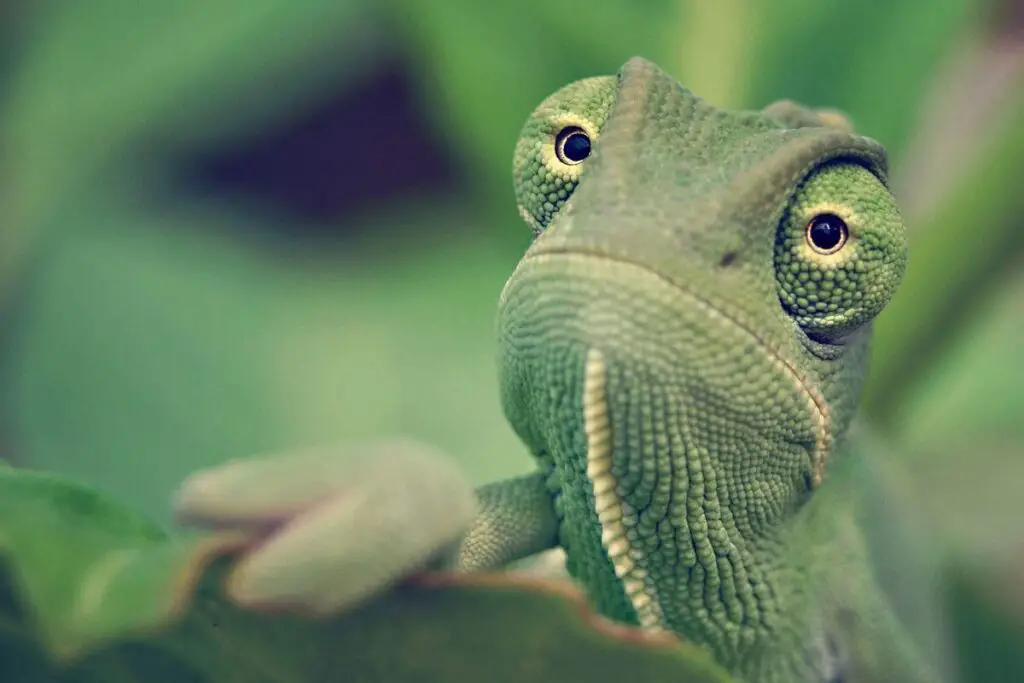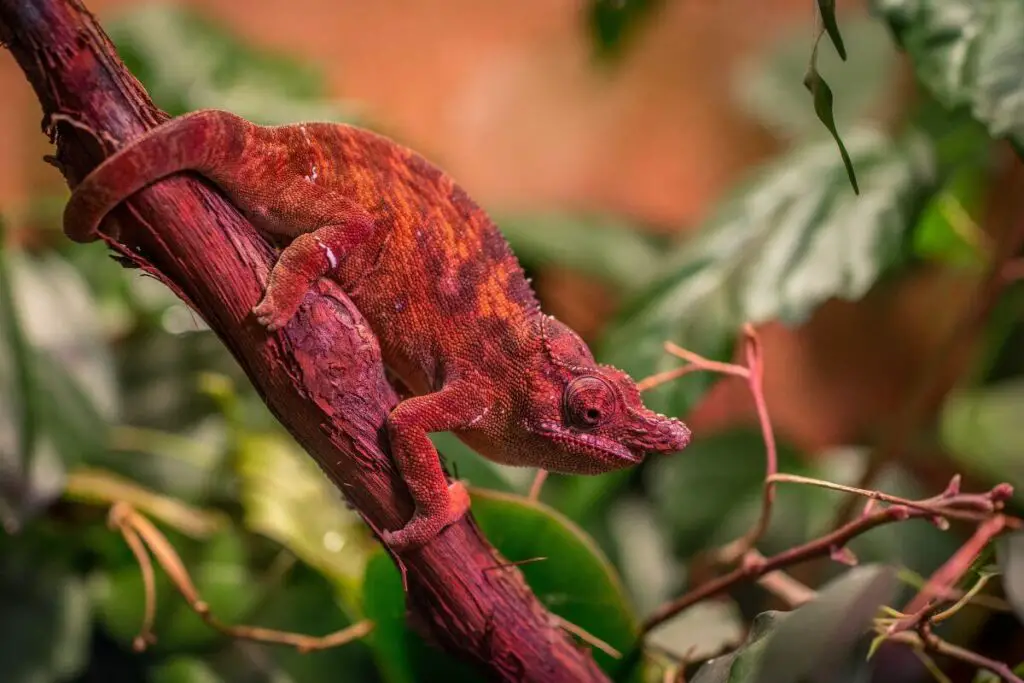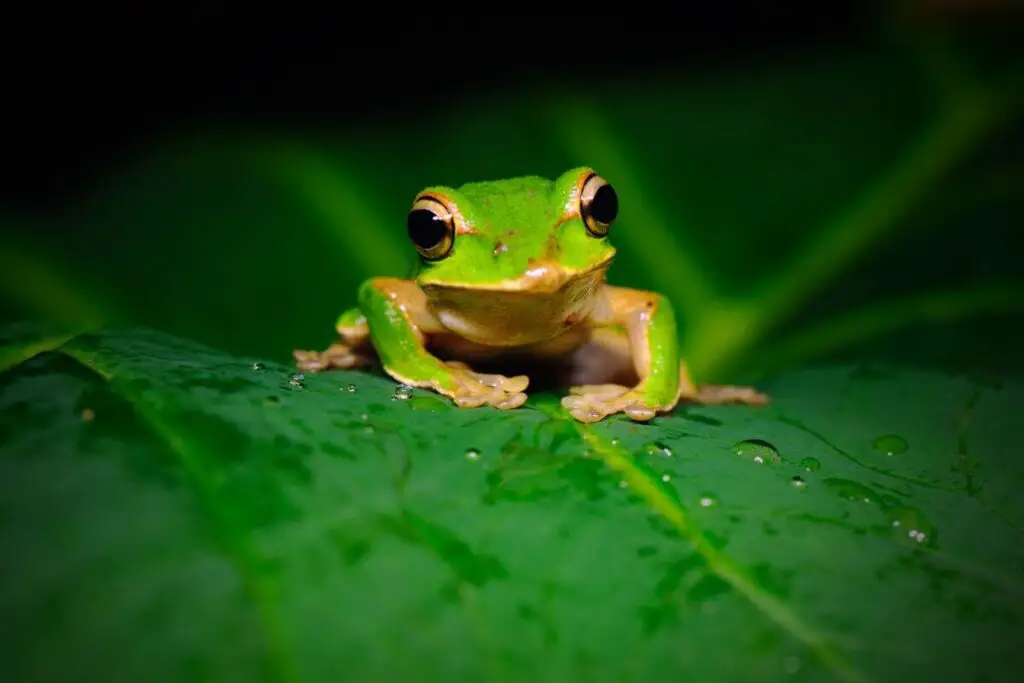Can Chameleons Live Together?
So many reptile enthusiasts envision a terrarium or cage filled with plants and branches and a “family” of chameleons (or most any other lizards, geckos, etc) all living together in peace and harmony. How incredible would such an environment be?!
The truth about reptiles, in comparison to human families or even other pets like dogs and cats, is that reptiles don’t really live as “family units” or even in groups. Reptiles, albeit for some very rare exceptions, are mostly solitary creatures. Unfortunately, chameleons are not animals that can live together or be housed in the same enclosure.
Reptile Roommate is a participant in the Amazon Services LLC Associates Program. As an Amazon Associate I earn from qualifying purchases.
Can More Than One Chameleon Be Kept Together?
Chameleons should never be housed together, especially if they have reached sexual maturity. Two (or more) chameleons kept together, even of the same species or one male and one or more females, will be a continual source of stress to one another; they’ll will have disputes over food, basking spaces, territory and the desire / aversion to mating.
There is one thing that will sabotage any success you might have in keeping a chameleon; and that thing is STRESS!
Stress Hampers Health
Stress Shortens Lifespan
Stress Kills
All this stress and combat will result in injuries and in most cases death. A chameleon keeper that puts the needs and health of their chameleons first, will always keep solitary animals.

Do Chameleons Live Together in the Wild?
No, chameleons are solitary creatures even in the wild. Chameleons will seek each other out to find a breeding partner and to mate and go their separate ways after the encounter. Even during this brief courtship and while breeding males and females will fight, bite, scratch and stress each other to the point of exhaustion.
Male and female chameleons parting ways after breeding allows them to heal, relax and calm themselves from the stress of the interaction. Reproduction takes a heavy toll on female chameleon bodies and the stress of a persistent or “rough” male is just too much for most females to deal with.
Chameleons may also cross paths as they are in pursuit of a mate or while hunting for food. These interactions, which can be two males, two females or any combination of the two can be just as stressful as mating. Many chameleons will fiercely defend their food or territory.
These battles usually result in the loser retreating to safety, a very hard (impossible) thing to do in the confines of even the largest of enclosures.
The “loser” isn’t the only one that suffers from its defeat; even the victor is stressed from the necessity of defending its turf and in maintaining that superiority. There is no getting away from the stress of interactions; the loser, the winner, the mate -all suffer from stress.
EVERYONE that has any experience with caring for chameleons will tell you that STRESS KILLS CHAMELEONS!
Can Different Chameleon Species Be Kept Together?
No matter the species, panther chameleons, Parson’s chameleons, Senegal chameleons, Jackson’s chameleons, veiled chameleons, etc cannot be kept together.
*the one or two (maybe) exceptions to this rule might be some pgymy or dwarf chameleons that do seem to get along in small communities when adequate space is present in the habitat -though this is something well beyond the inexperienced chameleon keeper
Popular, medium to large size chameleons species like those listed above do not do well when cohabitating. All the same stressors are present as when male and female or male/male pairs of the same species are housed together.
While many of these chameleons can be seen as tolerant of some handling or exposure to us humans, they really do become quite aggressive when confronted by another chameleon, regardless of species or gender. Even reflections in glass enclosures or a nearby mirror can cause aggression and stress!
Can Chameleon Enclosures Be Kept Next to One Another?
As mentioned earlier, even a reflection can cause a great deal of stress or cause a chameleon to act aggressively. So, even when housed separately, chameleons should have barriers or partitions between enclosures so as not to give a ‘direct line of sight’ to chameleon neighbors.
This sight-line barrier applies to both male/female neighbors as it does to chameleons of any species or sex. In order to provide a low stress environment for your chameleons, employing this partition/barrier strategy for multiple chameleon enclosures works wonders in lowering the potential for stress.

Can Male and Female Chameleons Be Kept Together; How Are They Supposed to Breed?
Yes, chameleons do need to spend some time together in order to mate and eventually reproduce. However, like with most reptiles, there isn’t some sort of relationship or bond that is formed during the courting period.
Can Male and Female Chameleons Live Together?
Chameleons do not live together as family units or as pairs in the wild; chameleons are solitary creatures. Even though male and female chameleons do spend some time together when attempting to mate, they will still end up fighting because of food, basking spots, and unwanted sexual advances. All these things cause stress and will be detrimental to your chameleon’s health.
Can Chameleons Be Kept Together When Breeding?
During breeding it will be necessary to keep both your male and female chameleons together in order for them to mate. During this time males will display, sometimes aggressively, in order to ‘attract’ a female and to prove that they are a suitable mate.
The courting display and actual breeding (if the female is receptive) can be quite stressful. It many times involves aggressive posturing, pushing, shoving and even biting. In the wild when a male chameleon finds a receptive female, they will mate and then part ways shortly after.
Likewise, the sooner that your chameleons can be separated after mating, the better off for both the male and female! Stressed from the mating process a female chameleon desperately needs time and a secure stress-free environment to recover.
Not only that, pregnancy is very stressful in and of itself, and the sooner that a male can be removed from the enclosure the sooner that the female can gather the strength needed to carry her offspring.
So, yes chameleons do need to spend some time together in order to breed but this time must be monitored and once breeding is accomplished, they two chameleons need to be separated once again.
The Big Lie / Illusion of Social Media and Chameleons
Look hard enough (unfortunately it isn’t hard at all) and you’ll find someone on TikTok or YouTube showcasing their “incredible” chameleon setup and how they keep numerous chameleons together and they all get along perfectly.
Well, just like everything on social media, nothing is exactly as it is portrayed. Just because you see a two or three minute video or some pictures of the supposed happy family does not mean it is reality!
Even if your favorite social media star is LUCKY enough to keep more than one chameleon together for an extended period, it’s only a matter of time before things deteriorate; and they will deteriorate.
Keeping a chameleon shouldn’t be a contest or achievement of ‘what can I get away with doing’ rather it should be about the health and the animal’s needs over our own desires.
But My Pet Store / Breeder Keeps A Bunch of Babies Together?
Right off the bat I’ll say that “pet stores” are NEVER an example of what to do or how to keep any animal! even the most caring and careful pet stores / breeders have a bottom line; and that line is to make money. While making money, there is a cost analysis done to determine absolute needs and what can ‘be gotten away with’ until animals are sold into new homes.
The housing accommodations in pet stores and at breeders are temporary and mostly concern very young chameleons that are not yet very big and haven’t reached sexual maturity. Baby chameleons are often kept in small groups where they are watched over and looked after with a careful eye.
Being so small and without going through sexual maturation, babies tend to pose much less risk to each other than even moderately aged chameleons. That said, even keeping baby chameleons in small groups is a very temporary situation.
Can Chameleons Be Kept with Other Reptiles?
Again, unfortunately for some, chameleons cannot and should not be housed with any other animals, reptile or not.
Other species of reptiles would either stress your chameleon by encroaching on their territory, acting aggressively towards your chameleon, competing for food, or even becoming food for you chameleon.
Any way you cut it, chameleons are best kept as solitary animals!

You Don’t Just Want Your Chameleon to Just Survive, You Want it to THRIVE!
All pet owners, aquarists, reptile keepers, dog/cat lovers we all should have one focus; putting our animals first!
Part of keeping chameleons (any many other reptiles) necessitates that we keep them as singular individuals; each in their own separate environment. It’s basic requirement of keeping a happy and healthy chameleon.
There are many that let their desire to “keep what they want to keep” and “how they want to keep them” that they lose sight of what’s best for the animal in an effort to satisfy their need. …and each and every time these people will eventually struggle to maintain the health of their animals.
There’s no point in keeping chameleon(s) just to try and keep it ‘alive’. Instead why not try to create the very best home that you can (and that includes housing them singularly) so that your chameleon can truly THRIVE!!


